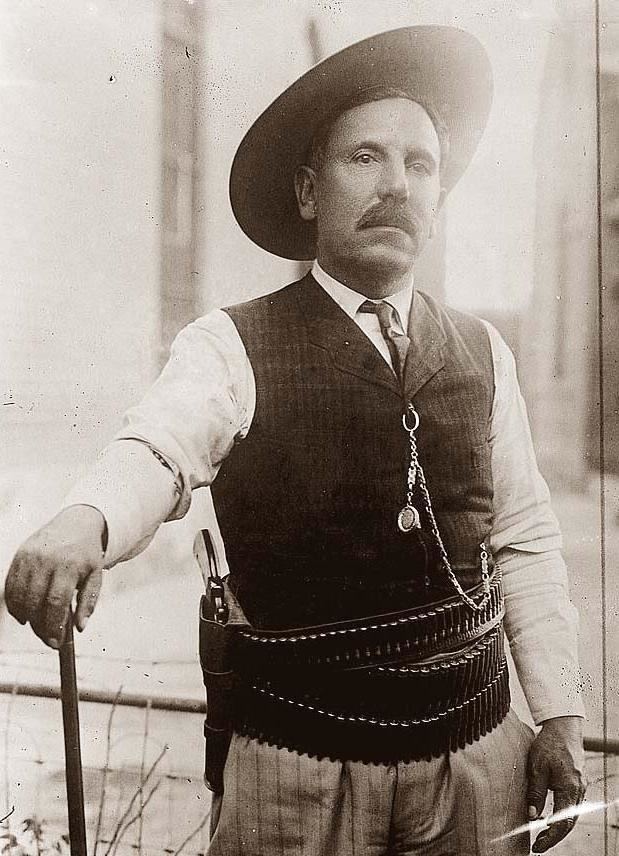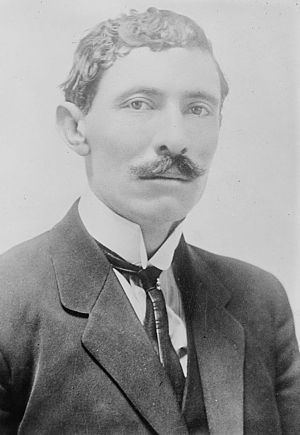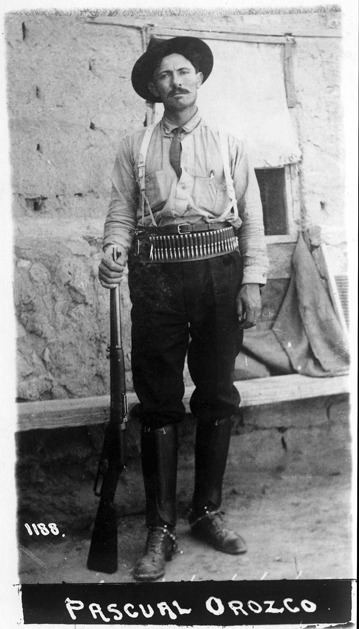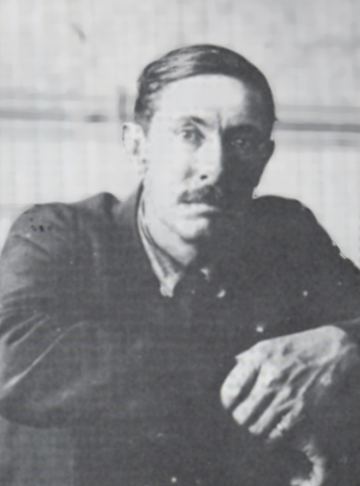Name Pascual Orozco | ||
 | ||
Died August 30, 1915, El Paso, Texas, United States Similar People Victoriano Huerta, Francisco I Madero, Felix Diaz, Pancho Villa, Porfirio Diaz | ||
1 la rebeli n de pascual orozco
Pascual Orozco Vazquez (in contemporary documents, sometimes spelled "Oroszco") (28 January 1882 – 30 August 1915) was a Mexican revolutionary leader who, after the triumph of the Mexican Revolution, rose up against Francisco I. Madero and recognized the coup d'etat led by Victoriano Huerta and the counter-revolutionary government it imposed.
Contents
- 1 la rebeli n de pascual orozco
- Pascual orozco
- Childhood
- Political ideas
- Under Maderos government
- Fallout with Madero
- Revolt against Madero
- Government in Exile
- House arrest in the United States
- Orozcos Last Ride
- In Popular Culture
- Books
- References

Pascual orozco
Childhood

Orozco was born to a middle-class family on Santa Ines hacienda near San Isidro, Guerrero, in the state of Chihuahua. He was a businessman in mining, commercialized minerals and became wealthy from investments in mines, particularly gold.

His father was Pascual Orozco Sr. His mother was Amada Orozco y Vazquez (1852–1948). The Vazquez family were second generation Basque immigrants. Pascual Jr. married Refugio Frias, and dedicated his youth to the transport of precious metals between the mining firms of the state. This allowed him to buy his own gold mine. Also he was uncle of Maximiano Marquez Orozco, who participated in the Mexican Revolution as Coronel of the Villista Army. In the first years of the 20th century he was attracted by the ideas of the Flores Magon brothers and, in 1909, he started importing weaponry from the United States in the face of the imminent outbreak of the Mexican Revolution.
Political ideas

He objected to the Porfirio Diaz dictatorship, and first ran into trouble with the law when caught with anti-Diaz literature in 1906. In May 1909 Orozco and Jose Ines Salazar purchased weapons in the United States and took them to Mexico on behalf of the Flores Magon brothers.

When Francisco I. Madero called for an uprising against Diaz in 1910, Orozco was an enthusiastic supporter and, on 31 October of that year, was placed in command of the revolutionary forces in Guerrero municipality. He led his forces to a series of victories against Diaz loyalists, and by the end of the year most of the state was in the hands of the revolutionaries. At this point, Orozco was a hero in Chihuahua, with over 30,000 people lining the streets upon his return. Madero promoted him to colonel, and in March 1911 to brigadier general, remarkably, these promotions were earned without any kind of military knowledge or military training. On 10 May of that year Orozco and his subordinate colonel Pancho Villa seized Ciudad Juarez, which Madero made the capital of his new provisional government.
Under Madero's government

On 31 October 1910 he was named jefe revolucionario (revolutionary leader) of the Porfirio Diaz Anti Re-election Club in Guerrero District. A week after the beginning of the war, he obtained his first victory, against General Juan Navarro. After ambushing the federal troops in Canon del Mal Paso on 2 January 1911, he ordered the dead soldiers stripped and sent the uniforms to Presidente Diaz with a note that read, "Ahi te van las hojas, mandame mas tamales". ("Here are the wrappers, send me more tamales.") His bellicose attitude allowed him to ascend rather rapidly through the ranks within the Maderist army. He was eventually made general, with Francisco Villa among his subordinates. After the seizure of Ciudad Juarez, Madero designated his first provisional cabinet, having Venustiano Carranza, a wealthy landowner like Madero, in the Ministerio de Guerra (War Ministry), a position that Orozco longed for. Venustiano Carranza would eventually become a President of Mexico. Orozco and Villa first confronted Madero by bursting into a meeting of his shadow cabinet after the first Battle of Juarez.
Fallout with Madero

After Diaz's fall, Orozco became resentful at Madero's failure to name him to the cabinet or to a state governorship. Orozco was particularly upset with Madero's failure to implement a series of social reforms that he had promised at the beginning of the revolution. Orozco believed that Madero was very similar to Diaz, whom he had helped to overthrow. Orozco was then offered the governorship of Chihuahua, which he refused, and Madero finally accepted his resignation from the federal government..
When Diaz presented his resignation, Orozco was named commander of the federal rural police (Los Rurales) in Chihuahua. In June 1911, Orozco decided to run for governor of Chihuahua for the Club Independiente Chihuahuense, an organization opposed to Francisco I. Madero. After receiving many admonitions by the revolutionary hierarchy, he was compelled to resign his candidature on 15 July 1911. Subsequently he refused a request to command the troops fighting Emiliano Zapata in the south. On 3 March 1912, he announced his intention to revolt against the government of President Madero. Orozco financed his rebellion with his own assets and with confiscated livestock, which he sold in the neighboring U.S. state of Texas, and where he bought weapons and ammunition even after an embargo proclaimed by U.S. president William Taft in March 1912.
Revolt against Madero
On 3 March 1912 Orozco decreed a formal revolt against Madero's government. Orozco's forces, known as the Orozquistas and Colorados (Red Flaggers), smashed Madero's army during several engagements. Seeing the potential danger that Orozco posed to his regime, Madero sent General Victoriano Huerta out of retirement to stop Orozco's Rebellion. Huerta's troops defeated the orozquistas in Conejos, Rellano and Bachimba finally seizing Ciudad Juarez. After being wounded in Ojinaga, Orozco was forced to flee to the United States. After living for some months in Los Angeles, with his first cousin, Teodora Vazquez Molinar' Gonzalez (1879–1956) and husband, Carlos Diaz-Ferrales Gonzalez (1878–1953) he was able to return to Chihuahua but extremely ill, affected with periodic rheumatism seizures.
After Huerta installed himself as President of Mexico in early 1913, Orozco agreed to support him if Huerta agreed to some reforms (such as payment of hacienda workers in hard money rather than company store scrip). Huerta agreed, and had Orozco, as Commanding General of all Mexican Federal forces, lead attacks against the revolutionaries, including Pancho Villa. Orozco defeated the Constitutionalist Army at Ciudad Camargo, Mapula, Santa Rosalia, Zacatecas, and Torreon before Huerta was deposed in July 1914.
After Huerta's fall Orozco announced his refusal to recognize the government of the new president, Francisco S. Carvajal whom he viewed to be similar to Madero. After briefly leading a revolt financed with his own money where he took in Guanajuato where he won several successive engagements against the Constitutionalists, he was forced to retreat because he lacked sufficient manpower to hold the ground he won. He was again forced into exile and was named "Supreme Military Commander."
Government in Exile
In efforts to overthrow Venustiano Carranza's government, Orozco and Huerta traveled throughout the United States, with the support of fellow exiles Gen. Marcelo Caraveo, Francisco Del Toro, Emilio Campa, and Gen. Jose Inez Salazar in Texas. Orozco traveled to San Antonio,St. Louis and New York. Eventually Enrique Creel and Huerta were able to strike a deal with the German government for the sale of $895,000.00 in weapons.
House arrest in the United States
In New York Orozco and Huerta finalized plans to retake Mexico. En route to El Paso by train on the 27th of June 1915 the two were arrested in Newman, Texas, and charged with conspiracy to violate U.S. neutrality laws. He was placed under house arrest in his family's home at 1315 Wyoming Avenue El Paso, Texas, but managed to escape.
Orozco's Last Ride
Orozco successfully executed a planned escape to Sierra Blanca where he met up with leaders and future cabinet members(General Jose Delgado, Christoforo Caballero, Miguel Terrazas and Andreas Sandoval). The official U.S. report stated that Orozco and his men had crossed by Dick Love's ranch and had coerced the cook to prepare him a meal and attend his horses, while Orozco and his men got ready to steal Love's cattle. When the owner arrived, they fled on the rancher's horses. The facts of this are often disputed because in other accounts it is believed that the horses belonged to Orozco and Love set up Orozco to seek revenge for an earlier dispute. Love used his accusations to persuade 26 members from the Thirteenth U.S. cavalry, 8 local deputies and 13 Texas Rangers to pursue the mysterious horse thieves whom he purposefully fails to mention by name to ensure their participation. The posse in pursuit converged at Stephan's tank just west of High Lonesome in the Van Horn Mountains Orozco, and his four men (Delgado, Caballero, Terrazas and Sandoval) were camped in a box canyon above Stephan's Tank where law enforcement caught and killed them. A Mexican version asserts that Orozco was murdered trying to resist the robbery of his own horses by Love and his men. On 7 October a local hearing against the 40-plus Americans involved was initiated, but the court found the people involved innocent of all charges.
On 3 September 1915 Orozco's remains were placed in space 13 of the Masonic Holding Vault at Concordia Cemetery in El Paso, Texas, at the decision of his wife, dressed in a full Mexican general's uniform, with the Mexican flag draping his coffin, in front of three thousand followers and admirers. In 1923, his remains were returned to his home state of Chihuahua and interred in the Rotonda de las Personas Ilustres (Rotunda of Illustrious Persons) Panteon de Dolores in Chihuahua.
